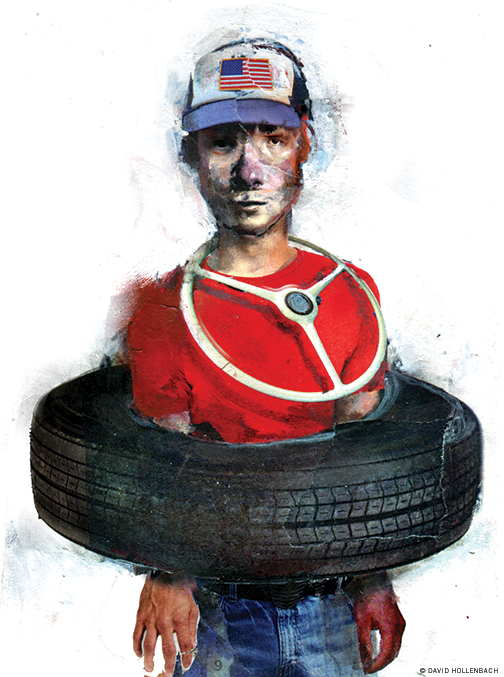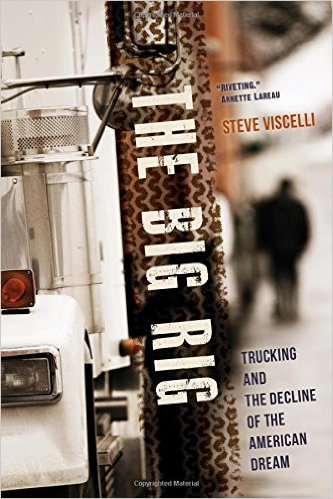
Shipping rules the American economy. From your floorboards to your roof shingles, from the pasta in your pantry to the magazine in your hands, virtually every object you own or consume was once moved by truck. According to the Federal Highway Administration, the total tonnage works out to roughly 350 pounds of freight for every American every day. Hauling it is not a job for the faint-hearted—as Steve Viscelli, a lecturer in the sociology department, learned first-hand by working as a long-haul trucker for four months. In The Big Rig: Trucking and the Decline of the American Dream (University of California Press, 2016), he draws from his own experience and over 100 interviews to examine how one of the best working-class jobs in the country became a dysfunctional labor market marked by low wages, debt peonage, and annual turnover rates that can top 100 percent, with repercussions for road safety and economic mobility. Viscelli, a Robert and Penny Fox Family Pavilion Scholar and senior fellow at the Kleinman Center for Energy Policy, talked with Gazette associate editor Trey Popp about the past, present, and possible future of trucking—and the lessons it holds for the broader labor force amid the rise of the “gig economy.”
What was the hardest thing about driving a long-haul truck?
The time away from home and on the road. It’s constant. You’re on the road for anywhere from 12 to 19 days at a time. And you’re exhausted by the end. You get home, you sleep for 10 or 12 hours straight, and you head back out a day and a half later. At the time I was married, but I didn’t have kids. And it was very hard to maintain relationships.
What was the best part?
You see the country. Not the way that some people think you might—the sights and the highlights—but you see all the places where stuff is made, and where stuff gets stored, and how goods get moved all around the country. And it really is fascinating.
How much did you make, on an hourly basis, all told?
Around $9.42 an hour. That’s just the time that I spent on duty. It doesn’t count the other 10 hours a day when you’re not working—that you have to be just living out of the truck, waiting to work.
Was there a golden age for long-haul truckers in America? And, if so, what enabled it, and what brought it to an end?
There was. It started with federal regulation of the industry in 1935, and ended in 1980. By the 1950s truck driving was as good of a job as unionized steel working or auto working, where workers had a lot of say through the union in what the working conditions looked like, and were fairly well paid. By the 1960s into the 1970s, truck drivers were actually doing better than virtually any other large group of unionized workers, bringing home somewhere on the order of, in today’s dollars, $100,000. The average truck driver would have been home on any given night, or at least every other night, and would have probably been working on the order of 50 to 60 hours a week at most.
So if truckers lost out in deregulation, who were the winners? You note that deregulation was supported by groups as diverse as the American Conservative Union, Ralph Nader’s Consumers Union, the American Farm Bureau, and the National Federation of Independent Businesses. Did they reap the rewards that they had hoped for ?
Some of them did—though I don’t know that they were all well-equipped to handle what was coming. The ultimate beneficiaries were Big Box retailers. Walmart and Best Buy, Staples and Home Depot: their market dominance is inconceivable without trucking deregulation. That’s the real winner. The other losers were your mom-and-pop shops. They’re the ones who have been really eliminated from a lot of markets. And a big part of that is that they can’t get the economies of scale on shipping that a Walmart can. Yet, oddly, companies like Walmart pay their truck drivers really, really well.
That’s an interesting dynamic. It’s clear that the best trucking jobs are in niche markets—like hauling hazardous materials—or in point-of-sale delivery jobs that oftentimes involve more physical labor, unloading the truck. Yet even those employers say they have a hard time finding qualified drivers. Why?
Qualification is the first obstacle. You’ve got to be driving for at least a full year, usually two, and have a completely clean, safe driving record—no accidents, no speeding tickets, et cetera—to get into a lot of these things that pay better. That can be an obstacle when you’re doing the kind of driving where you’re working 80 hours a week. And it may not be serious accidents, but you may get speeding tickets. You’re paid by the mile, so there’s an incentive to go faster, to cut corners—sometimes literally.
Periodically you read that there either is or will soon be a shortage of truckers on the order of hundreds of thousands. What do you make of those stories?
That is all part of the bigger picture of employers being able to control the narrative around the labor market. What they’re trying to do is get this fresh crop of workers in that they’re going to train in a month or two months and have them working for six months or so. Most people leave within six months. And part of the reason that they’re able to make that work is because you and I are paying for it, partially, through our tax dollars.
How?
There are lots of workers who get displaced from other jobs and use programs like the Workforce Investment Act, or are veterans using the G.I. Bill. These workers get access to grants or loans that are subsidized by tax dollars. So rather than pay drivers what they think would be enough to retain them—which most executives admit would probably be somewhere in the range of $70,000-plus per year—they continue to pay them $35K to $40K and then just bring in a new crop of workers.
The problem is now they’re running out of supplies. They’ve essentially run through white and black men—the standard labor supply for them. So now they’re trying to get women in. That’s super, super tough. The job is horrible for women. There’s an incredible potential for sexual harassment and sexual violence.
What are two or three concrete steps that could improve driver pay, safety, and satisfaction—without massively disrupting an economy that partly depends on cheap shipping?
The first thing we need to do is to clarify what an independent contractor is. The industry was initially regulated because it had tendencies toward destructive competition, which basically resulted from the fact that you can’t store up trucking services when you have slack demand. So what happens is you get a lot of volatility in trucking markets, and potentially a lot of underinvestment in equipment. In the modern unregulated industry, the solution has been to shift the risks of truck ownership to the workers themselves. Companies insulate themselves from the costs of market [and fuel-price] volatility by getting the workers themselves to buy the trucks and pay the operating expenses. That’s what they’ve achieved with these independent contractors.
But most of these “independent” contractors don’t have control over the work that they’re doing. They’re assigned this work. There’s only a certain amount. They only work for one company. They can’t play the market for higher rates. So my opinion as an economic sociologist is that they’re not at all independent businesses. They’re clearly workers.
We need to have a conversation about this stuff, especially in light of the changes in labor markets that are happening with the gig economy.
So do you think trucking is a bellwether with regard to the changing relationship between companies and their labor forces?
This is a much bigger conversation than just trucking. These problems are only going to become much more widespread. For instance, if we end up with a new “independent worker” classification—as Uber’s been pushing for—that says that workers aren’t responsible for payroll taxes like Medicare and Social Security, well, most workers don’t really think much about the fact that half of their Social Security contribution is coming from their employer. But if the employer is no longer doing half of that, what does that mean politically for support for Social Security? How this stuff gets worked out in terms of the regulations is going to have really important consequences for our politics and social safety net.
Some people predict that self-driving trucks are going to completely reinvent the marketplace. What do you think?
We’ll have autonomous trucks having greater market penetration long before we have cars, probably. People are working on platooning, which is an interesting concept where a lead truck is basically linked by radio to a drone. I think you’re going to see something that looks like a train: a pilot is going to be in the lead unit for a long-distance haul with maybe five or six drone units following it that are self-powered. And that’s going to be way more cost-effective. It’s great environmentally; you can eliminate the tractors and sleeping arrangements for the driver and all that stuff to make them much more fuel efficient.
I see significant increases in productivity by eliminating some driving jobs. But I think you are going to end up upgrading the jobs. Because you’ll need a more skilled and experienced driver. You don’t want them tired. You don’t want them working 70 hours a week. So they’ll get paid better. They’ll have better working conditions. And it’s much more likely that they can run a regular lane and be headed back home that night.
EXCERPT

I’ve been on the road solo for three months now. In the beginning I enjoyed driving new roads and seeing new places. But the novelty of the work has worn off. The only part of the job that is still fun is blasting the air horn for the kids on the side of the road furiously pumping their clenched fists up and down. Good days on the road blend into one another now—they are just a blur of endless highway miles. Bad days, on the other hand, stick out. On bad days the work is frustrating, even insulting.
On Monday, July 4th, things turned bad. [I was ordered to] pick up a preloaded trailer of automotive glass, and haul it 210 miles to a factory near Columbus, Ohio. The glass was scheduled for delivery on Wednesday at 12:30 p.m. I did a trip plan for the load and realized I would be thirty miles outside Columbus that night—Monday night—at 6:00 p.m. That meant I would be sitting unpaid for more than forty-two hours. In the previous week I earned an average of more than $130 a day. For Monday’s driving I would earn a little under one hundred dollars. Tuesday I would earn nothing. And Wednesday I would be lucky to earn fifty dollars by the time I dropped the glass and picked up another load. I texted about moving up the delivery time and was told nothing could be done until the next day—the customer was closed for the holiday.
So, I remember July 5th. I woke at 7 a.m. and by 8 a.m. I had a text message from my driver manager. He told me the shipper was willing to move up the delivery appointment the next day by two hours but had no space in the warehouse to take the glass any earlier than that. Now certain that I was stuck at the truck stop for the entire day, I took the free shower I was given for purchasing 150 gallons of fuel the day before. After that I read a little in my bunk. But after long stretches of driving and working alone, I wanted to interact with people. So by early afternoon I headed into the truck stop’s driver lounge and watched the apparently endless parade of crime dramas available on cable TV.
Conversations about everything from the current NASCAR standings to the ongoing wars were struck up easily, and typically ended just as abruptly, with either the Law & Order theme or a name and shower number called over the PA system. None of the participants in these conversations would likely ever see each other again. We were all just trying to fill the difficult time between work sessions, when most truckers simply try not to dwell on what they are missing at home.
Like decent food. Late in the afternoon, I moved across the stop to the restaurant. The buffet is by no means good food, but in addition to heaping piles and simmering pots of unhealthy calories—some of which can only be identified because they have labels—it has a decent selection of hot foods, like roasted chicken, and, more importantly, whole, unfried vegetables (a true luxury on the road) in the salad bar. Most importantly, it only costs $15, including tip. The buffet is the only real meal I’ll have all day and is the best consistently available food option I have found while driving. I just can’t eat fast food regularly—I promised myself I would not ruin my health doing this research. Unfortunately, bad overpriced food is a serious workplace hazard most truckers can’t easily avoid. It’s difficult to pack enough fresh food to take on the road, and there is rarely the time to search out decent food. Even if you could, and you’re confident you can find a place that you can safely park your truck, the company is going to count the out-of-route miles against you when they figure your quarterly bonus. Therefore, many truckers pay the costs of eating at truck stops in higher rates of heart disease, obesity, and diabetes.
Days like this tell you something as a trucker. They say: your time is not important. Your paycheck is not important. Whether you are home with your family for special events and holidays is not important. You are not important. As I write this, years after the experience, I can still remember how I felt. How angry I was. I knew what I was angry about—I was wasting a day of my life sitting at a truck stop. But who was I angry with? It wasn’t my driver manager’s fault. He didn’t plan this load for me, and his brief text messages suggested he was genuinely troubled by my plight. What about the load planners? They don’t know me from Adam, and they only have the loads to assign that the salespeople send them. And the salespeople can only sell my services for loads that need to be hauled. The company would certainly have given me the day off if I was close to home, but I wasn’t. I was 700 miles from home, and they certainly weren’t going to pay $300 for fuel to get me there.
So it was nobody’s fault, at least no one that I could reach with a text on the satellite-linked computer. And that is how it is supposed to work. As a trucker I was paid for a little more than half the time I worked. I sat unpaid with nothing to do for hours, sometimes days. My July 5th wasn’t a mistake, it was a predictable, routine outcome of the way the work of truckers is organized.
From The Big Rig: Trucking and the Decline of the American Dream, by Steve Viscelli, copyright 2016. Reprinted with permission of University of California Press.




